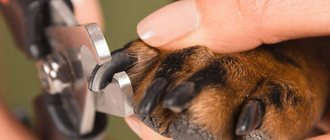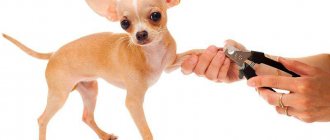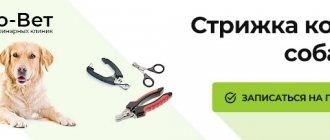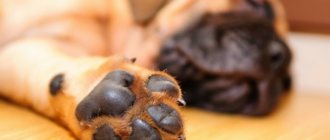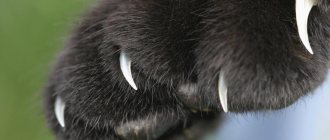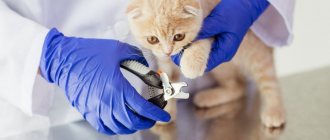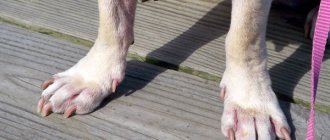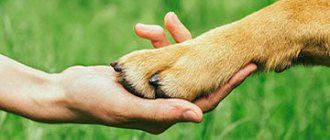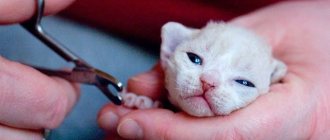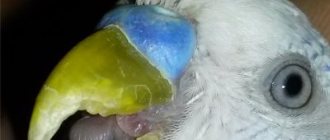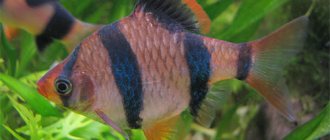Unfortunately, not all pet birds have the necessary object in their cage on which they could sharpen their claws. Therefore, the owners of such parrots have to trim their pets’ claws themselves or seek help from a veterinarian. However, not everyone has the opportunity to periodically contact a specialist to perform this procedure. Therefore, in this article I will tell you how to properly trim the claws (nails) of a budgie at home.
Natural nail polishing
The birds' paws are tenacious and well-developed, each of the 4 fingers, two of which are directed forward and two directed back, ends in sharp claws. This structure helps to grasp branches, take food and other objects. But if the claws are long, the task becomes more difficult for the parrot. In their natural habitat, the bird wears them off independently during physical activity. They are shortened due to the following effects:
- running on rocks and ground;
- landings, movements and take-offs from branches;
- picking and holding fruits in the paws.
On a note!
At home, your pet can shorten its own claws. But, if one of them reaches a critical length and the parrot does not gnaw it on its own, it will break off and the paw will be injured.
Claw sharpening as prevention
Under natural conditions, a parrot's claws wear down naturally in the process of contact with tree branches and bark, stones and other hard objects.
When keeping birds in captivity, drainage is necessary, but it must be carried out by the owner. This procedure provides prevention of various diseases and injuries.
So, with strongly overgrown claws, the load on the paws will be uneven, and therefore their deformation may occur, which will negatively affect the condition of the pet’s bones and joints.
In addition, parrots constantly clean their plumage with their beaks and paws. Due to the long and sharp claws, the pet can injure itself . A claw fracture is also possible. This can cause severe pain or even significant bleeding.
Thus, sharpening claws is an important preventative procedure that allows you to avoid many diseases and injuries.
You can use some tips that will help the bird sharpen its claws on its own, so there is no need to trim them. To do this, it is recommended to use various wooden toys, perches and other elements that help grind down the stratum corneum.
It is advisable to put a hemp rope in the cage, and also hang a wooden ladder. Sometimes bark or cones are laid.
Why do you need to trim your parrot's claws?
Poultry often experience discomfort from excessively long nails. Often this condition is the result of incorrectly selected equipment for the pet - a perch of the wrong size, lack of edging made of natural fibers. In order for the claws to shorten naturally, the cage must be equipped with wooden perches. Their thickness should be such that the bird cannot completely wrap its paw around it - then the claws will begin to touch the rough layer of the perch, gradually grinding off against it.
Nevertheless, a haircut is necessary, since such a trim may not be sufficient. The manipulation must be performed for the following reasons:
- The parrot has discomfort when walking on flat surfaces.
- Unnatural distribution of pressure due to incorrect positioning of the paws - the toes are raised up, this provokes pain in the bird.
- Excessively long claws prevent the parrot from sitting comfortably on the perch.
- A pet sitting on the arm or shoulder will scratch the skin of the person holding it, which is quite unpleasant.
- While scratching, a bird can accidentally injure itself with a sharp claw.
- The pet will strive to solve the problem on its own - this often causes various injuries to the bird.
- If the claw is too long, it can split and break, causing bleeding - the parrot will feel severe pain.
It is better to trim the parrot's claws at home, otherwise there is a high probability of serious injury to the bird's paw. This happens because the bird clings to a cage, tulle or something else, but cannot let go of the object and continues to move. The result of this situation can be a dislocation, and in some cases, a fracture of the pet’s paw. In the best case scenario, the bird will tear out its claw.
Attention!
Overgrowth of claws can occur due to liver disease, knemidocoptosis (mite infestation), impaired metabolism and poor diet, poor living conditions or previous finger injuries. Therefore, it is worth monitoring the condition of the bird’s claws in order to notice the problem in time.
Why do you need nail trimming?
Parrots living in the wild constantly jump from branch to branch, jump on the ground, bumping into stones, protrusions of roots, tubercles, and also cling to branches and tree trunks with their paws in order to move along them. Therefore, they are not bothered by overgrown claws - they grind down naturally.
Domestic parrots do not have this opportunity. The maximum that the owner can offer them is a couple of smoothly polished, or even plastic, perches. That’s why pets’ claws grow very long.
If you don't trim your parrot's claws, the bird can have a lot of problems:
- discomfort when walking on flat surfaces;
- due to incorrect positioning of the paws, pressure is unnaturally distributed on them - the toes lift up instead of fitting tightly to the surface, which causes pain in the paws;
- It is uncomfortable for the parrot to sit on the perch - long nails get in the way;
- trying to scratch itself, the parrot often injures itself;
- a claw that interferes with the bird may begin to peel and break, causing acute pain and severe bleeding;
- a parrot, released to fly around the room, can catch its long claw on a curtain or fleecy carpet, or become entangled in the curtains. When trying to free a paw, there are frequent cases of dislocation or fracture; in the best case, the pet pulls out its own nail;
- leg injury also occurs if the bird gets caught in the bars of the cage;
- A parrot sitting on a person’s shoulder or arm scratches the skin of its owner with its long claws - but this is, rather, the problem of the owner himself.
How to properly trim the claws of a budgie, cockatiel and others at home
When the bird trusts the person and does not show concern, you can trim alone, but it is more convenient to do it together. To determine the length of the cut part, you need to look through the claw into the light - the veins (capillaries) will become visible, they cannot be touched. The part free from them is divided mentally into 3 and the outer third is cut off. The end should be straight; you cannot cut it at an angle. It is also prohibited to file claws. Correct procedure:
- put on gloves and place the bird on the palm with its back, fixing the wings and head;
- the claw is trimmed in one movement, without delay;
- make sure that other fingers do not get caught between the rings of the scissors.
When the parrot is very worried about the procedure, you can treat 1 finger per day. Trimming nails often causes stress in birds. To calm the bird, you need to first prepare a treat for it, which is given upon completion of the manipulation. After trimming, the pet is left alone for several days - any procedures are contraindicated, as are worries. You can let a parrot out of its cage, but only if the bird comes out on its own - you cannot force it to do anything. It is recommended to appease small species of parrots (budgies or lovebirds) by hanging a new toy in the cage.
How to trim a budgie's claws
Budgerigars, like larger species, are advised to have their nails trimmed. The only caveat is the small size of the bird, which complicates the task. But it should not lead to doubt whether this should be done.
It is best to trim a budgie's claws together. An assistant is needed to securely secure the bird. A well-lit place is chosen for the procedure. Then the necessary tools are prepared. To trim a parrot's nails, you will need:
- nail clipper or nippers;
- a piece of cotton wool;
- gloves;
- any hemostatic agent.
An assistant securely holds the parrot with both hands. It is important that the bird cannot move during the procedure. Then put on gloves and inspect the nails under good light. A blood vessel on the finger will be visible. It is forbidden to damage it; it is painful for the parrot.
Important! The cut is made quickly and accurately. In this case, you need to monitor the safety of surrounding fingers.
The parrot's claws should be trimmed at a distance of about 2–3 mm from this vessel. In this case, the cut is not made transversely, but slightly at an angle. You can navigate by the natural shape.
What to do if you hit a blood vessel
No matter how carefully the procedure is carried out, it is possible to accidentally hit a blood vessel. As a result, blood will begin to flow. At this time, it is important not to panic, but to help your pet in a timely manner. Take a cotton wool moistened with hydrogen peroxide and apply it to the damaged area. Instead of peroxide, a crystal of potassium permanganate or any other hemostatic powder is also suitable. The blood will stop bleeding within a few seconds.
Birds experience fear when their nails are cut. Therefore, after the procedure, the pet may avoid the owner for some time. If the parrot is talking, then its ability also disappears for a while. After the procedure, it is advisable not to touch the pet. You can only appease him with your favorite treat or a new toy.
What tools will you need for a haircut?
Before trimming a parrot's claws at home, you need to prepare the appropriate tool. The main thing is a guillotine (claw cutter), which you can buy at a pet store. If there is no such item, it is permissible to use sharp nail scissors. In addition to the tool, you should also keep ready:
- antiseptic;
- cotton wool;
- hemostatic agent.
On a note!
Hydrogen peroxide can be used as a hemostatic agent. But in pet stores there are special powders that easily stop bleeding and do not cause burns.
How to trim a parrot's claws
So how do you still need to cut the claws of a budgie? That is the question. To achieve the most effective and safe result, the best way would be to contact a specialist, however, this possibility is not always available. That is why it is important to be able to provide the necessary assistance to your feathered pet on your own. The main thing is to arm yourself with determination, pick up the right tools and enlist the support of a couple of assistants. After carrying out the procedure several times on their own, many owners of pet birds acquire automatic skills in trimming the nails of budgerigars.
Haircutting tools
To quickly and efficiently trim the nails of a cockatiel or budgie, you will need the following tools and equipment:
- nail clippers or scissors;
- nail clipper;
- rubber gloves or thick mittens;
- pharmaceuticals to stop bleeding.
Manicure rules
When starting a difficult procedure, decide for yourself whether you need assistants. If you and the bird have a good relationship, the parrot trusts you and is easy to handle, then the manicure can be done alone.
Those owners who cut their birds' nails themselves go through a number of stages of this painstaking process and follow the following recommendations:
- The parrot's body is slightly squeezed in the left hand (if the owner is right-handed) and they begin to carefully trim the claws with previously prepared means.
- It is better to trim the claws obliquely, observing the direction of natural growth.
- When performing the procedure, it is necessary to carefully monitor the capillary vessels of the bird so as not to inadvertently touch them and provoke bleeding.
- In cases where the parrot is very worried, screams and breaks out of your hands, you should resort to the help of your family, who will hold the bird while you trim it.
- After completing the process, you need to give the bird a rest and recover from the stress it has experienced. At this point, your pet will enjoy a new toy or treat.
What to do if there is bleeding
Regardless of the degree of care taken when trimming a parrot's claws, there is always a risk of bleeding. This usually occurs when there is slight damage to the foot itself or the capillary layer in the plates. To eliminate bleeding, you should moisten a piece of cotton wool or sponge in hydrogen peroxide and lightly press on the damaged area. As a replacement, it is permissible to use any other hemostatic agent or manganese crystal.
A clot should form at the site of injury, which should not be touched until complete healing. It is recommended to wash the area with chlorhexidine for 1-2 days. If blood gets on the feathers, it should also be washed off with peroxide, and then rinsed with water from a spray bottle. The parrot may be lethargic for the first 24 hours, but then everything will stabilize and it will begin to eat and behave as usual. If the bleeding cannot be stopped, you should urgently consult an ornithologist.
What to do if you hurt your parrot
Don't panic if you accidentally cut a nail incorrectly and damage a blood vessel. Just do not hesitate to stop the bleeding that occurs. To do this, carefully sprinkle a special powder (Bio Groom hemostatic powder) onto the wound, making sure that it only gets on the wound.
You can also soak a cotton swab in hydrogen peroxide or a solution of potassium permanganate and press on the wound for a few minutes to clot the blood. Do not pour potassium permanganate crystals directly onto the wound - this can cause a burn to the bird.
Prevention of claw regrowth
The growth of a parrot's claws in its natural environment is limited, therefore, as a preventive measure, various methods are used to bring living conditions as close as possible to natural ones. To do this, you should reduce the bird's stay on soft surfaces - the back of the sofa or the owner's shoulder. In order for the parrot's claws to have time to grind down, you need to ensure:
- Balanced diet with added vitamins and minerals suitable for poultry.
- Using perches (diameter no less than 1.5 cm) and ladders made of natural untreated wood - better with bark.
- Adding stones to the platforms, on which the parrot can also sit and grind off its claws.
On a note!
Proper surfaces only help slow down regrowth, so you shouldn’t expect long nails to shorten on their own - they will still have to be cut.
Trimming a parrot's claws is one of the important procedures when keeping such a pet. They can lengthen significantly and lead to injury. But pruning should be done with caution, following the rules, which include preparing the tool, calming the pet and being attentive. To prevent long claws, it is recommended to take preventive measures - install suitable perches and add more hard surfaces.
Why do they cut their hair?
The life of budgies in the wild is very different from life in captivity. In nature, birds constantly fly, jump from branch to branch, sit on rough tree branches, so their claws themselves wear down as a result of friction against natural materials. In the cage, all the perches are smoothly polished and made of unnatural materials, when interacting with which the claws do not grind down. Small budgies, medium-sized cockatiels or large macaws need to have their nails trimmed.
Too long claws cause severe discomfort to your pet for many reasons:
- marigolds can cling to tissues on which the bird lands during flight, in which case the pet can dislocate a paw or twist a claw;
- the parrot feels pressure to move on flat surfaces and cannot sit comfortably on the perch;
- a pet can harm itself by trying to scratch its paws with overgrown nails;
- paws also cling to the bars of the cage.
In addition to natural growth, there are situations in which nail growth becomes too strong due to various diseases or problems in the body. Among these:
- liver diseases;
- curvature of fingers or other deformities associated with previous injuries;
- parasites (most often mites);
- poor living conditions;
- poor and unhealthy diet, which disrupts metabolism;
- lack of vitamins and minerals in the body.
